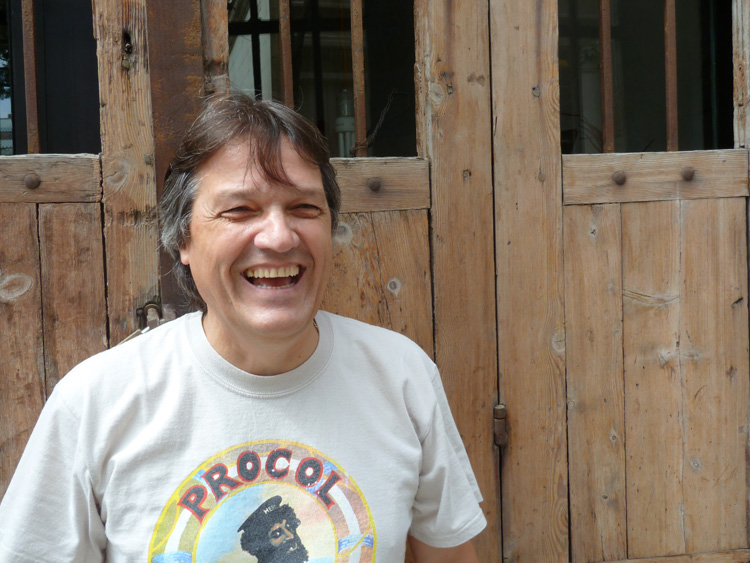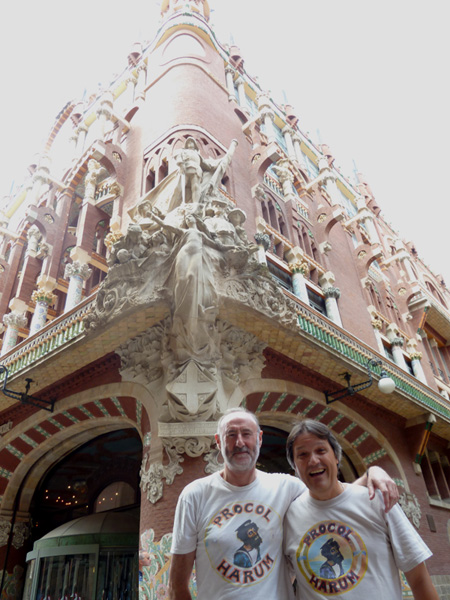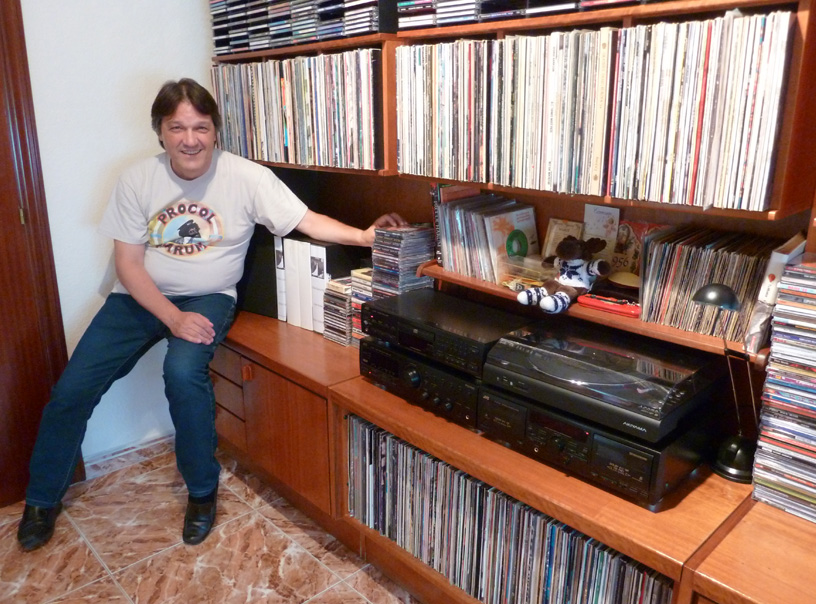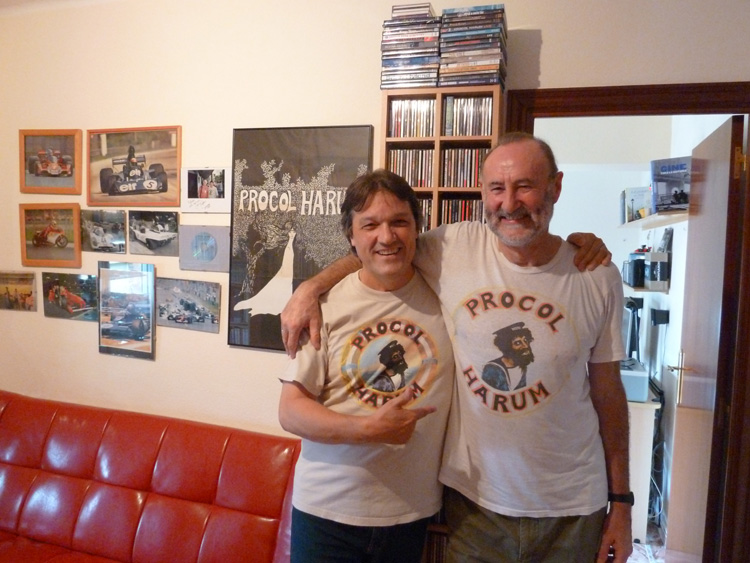
Procol Harum
Beyond |
|
|
|
|
One Thousand One Hundred and Fifteen Shades of Pale
Barcelona, whose hosting of the Olympic Games in 1992 consolidated its status as a global city second to none, is home to an absorbing array of archives and museums. The complex of Gothic buildings around the Plaça del Rei, for instance, houses the Archivo de Aragón. A document there records the return of Christopher Columbus from his discovery of the New World in 1492, the Admiral of the Ocean Sea journeying to Barcelona to present his findings, and lay claim to a share of the spoils, in person to the Catholic Monarchs of Spain, Isabel and Ferdinand, who had given his expedition royal endorsement and funding. He met the mighty couple in the Saló de Tinell, a vast banqueting hall that also served as a forum for parliament. The Museu Nacional d’Art de Cataluyna, its “national” designation asserting unequivocally Catalan aspirations for independence and the severing of political ties with Madrid, is another notable attraction, its displays of Romanesque art salvaged from dead or dying settlements in the Pyrenees alone making any trip to Barcelona worth while. One archive and museum, however, not on the agenda of most visitors is a giddying collection that pertains to the passion of Martín J Pérez.
Martín is an ardent follower of Procol Harum, and has made it his labour of love to track down not only versions of A Whiter Shade of Pale played by the band itself but also covers of the song recorded in multiple musical guises since the hit single was first released in May 1967. To date, Martín has logged some 1,115 recordings of the piece. Forty-eight of them are by Procol Harum, the rest by a staggering range of interpreters, perhaps the best known in the English-listening world being Joe Cocker, Annie Lenox, and Willie Nelson. During a recent visit to Barcelona, Martín invited me to his house for a sample hearing. I listened to five very different offerings, a proverbial drop in the bucket, but a memorable one nonetheless.
Beforehand, though, Martín picked me up in his taxi and gave me a tour of the city that no guide book features, highlighting personal touchstones as much as historic landmarks.

“There’s where the Zeleste club was, where we got to hear rock music played live after Franco died.” He points to a recess near Santa María del Mar, a magnificent church close to the Born neighbourhood where Martín grew up. The dictator who admired Hitler and Mussolini may have died in 1975, but the scars of the civil war he unleashed in 1936 still linger: Martín shows me a bullet-ridden wall left to mark where children, seeking shelter from an air raid, lost their lives. We wander along Carrer Santa María del Born. “The street we lived on no longer exists. They demolished the tenements between it and an adjacent one. Today, where the streets used to be lies on both sides of an open space.” The wrought-iron Born market, an Eiffel-inspired gem designed by Josep Fontseré, is now a cultural centre, tastefully restored. We walk around while Martín remembers fondly. “It was Carlos Santana who blazed the trail. He was the first big star I ever heard play here live.” Waves of nostalgia result in an effusive grin. I take his photograph (above). Martín then shows me the Palau de la Música Catalana, an Art Nouveau concert hall built by Lluis Doménech i Montaner, for me a modernist edifice far more appealing than some of the extravaganzas concocted by the far better known Antoni Gaudí. “Here’s where I would love to hear Procol Harum play.” We pose to have our photographs taken (below), the first in line for a concert of the mind.

Next, Martín whisks me off for lunch, the centrepiece of which is paella -- a mammoth feast was served -- prepared for us by Martín’s wife, Carmen. Accompanied by fine Albariño wine, chilled to perfection, a siesta afterwards is obligatory. Upon wakening, music beckons.
“Here’s the latest arrival,” he says, putting on a duet rendering of Procol Harum’s signature song, played by Sven-Invart Mikkelsen on organ and Jochen Brusch on violin, recorded in 2012 in Kevelaer, Germany. Its cathartic melancholy does more than pay justice to the album’s title, Trost in Zeiten de Trauer, which my high-school German (not perfect, these days only functionally approximate) translates as Trust in Times of Sorrow. How many of us have sought such solace in that soothing mix of music and words? Martín prefaces the second selection with an anecdote.

“I asked Gary Brooker, when he played here on 13 July 2001, with Bill Wyman’s Rhythm Kings” – he shows me a photograph of him and Gary there in situ together – “which cover of ‘A Whiter Shade of Pale ‘was his favourite. It turns out it’s mine too.” The room began to hum considerably harder as King Curtis and Billy Preston, recorded live at the Fillmore in San Francisco in 1971, filled it with their stunning (respectively) saxophone and keyboards acumen. Next up was a version that I knew well, for I was present when it was recorded: Procol Harum live at the Paradise Club in Boston, 18 May 1992, with Don Snow on Hammond organ, Geoff Whitehorn on guitar, Dave Bronze on bass, and Mark Brzezicki on drums. My presence is actually registered on the recording in an exchange with Gary -- his piano playing and singing were superb that night -- prior to “A Salty Dog.” It runs something like this:
Gary (in mimic Scottish accent): On a clear day in Kirkcaldy, which is in northern Scotland, Scotland is that wee country just north of…[at this juncture in the preamble I shouted “Yea” and waved my hand. Being close to the front of the stage, my antics caught Gary’s attention].
Gary (in Southend-on-Sea English): Are you Scottish?
George (in Glaswegian English): Glasgow!
Gary (his first utterance is in mimic Scottish accent; thereafter, he resorts back to Southend-on-Sea English): Glasgae? What’re you doin’ 'ere then?
George (in Glaswegian English): Following you!
Gary: Following us! You were in Glasgow last week, I remember that face…I forgot what I was going to say now. I was talking about auld Kirkcaldy. Well, I used to live there in a seaman’s hostel -- in a seaman’s hostel. Boy, my room was as big as a shoebox. But I always woke up in the morning to the sounds of the small birds. That’s it. True story.
Martín roars with laughter when I identify my cameo part to him.
“Is that really you?”

As Geoff’s guitar tweaks a seagull simulation, I assure him that it is. Martín continues to chuckle as he puts on selection number four, a rendering of “A Whiter Shade of Pale” that hails all the way from Malaysia. The fifth and final version is not a cover of the song per se, but one in which a verse of the chorus is threaded into a song about the travails of someone decidedly down in his luck, the vocals delivered in clipped Barbados calypso by a group called The Sandpebbles. “A Whita Shade ah Pale” is the colour the protagonist’s face turns as he endures calamity after calamity, always to fight another day no matter what befalls him.
Five cuts of “A Whiter Shade of Pale” from an archive of 1,115 – and counting. For still – of this Martín is in no doubt – there’ll be more.
[PS: For the geographical record, Kirkcaldy is a seaside town in the
Kingdom of Fife, which lies not in northern but in east-central Scotland,
across the Firth of Forth from Edinburgh. What Gary was doing in a seaman’s
hostel there is anyone’s guess.]
More about Martin Awsop
| Paler-friend snaps here |
George's Procol book for sale
Martin is the co-webmaster of a website
dedicated to A Whiter Shade of Pale.
Visit
it here